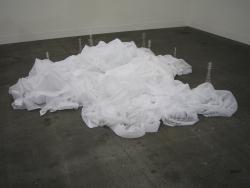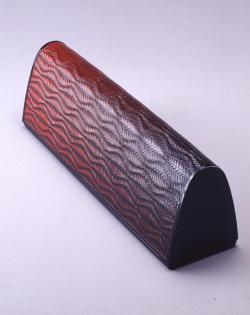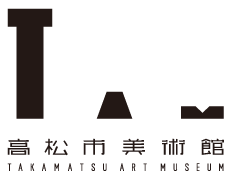PERMANENT Collection 1st term 2018 Changing,Shapes Appreciate “Urushi” Lacquerware from Base Materials
PERMANENT
April 5(Tue)-June 24(Sun),2018
Changing,Shapes
Artists work changes on materials to produce forms. They sometimes squeeze paints from tubes on canvas to make pictures of scenes and still-lifes. Or they form figures of animals and people from lumps of clay. As a result, standing before their works, in addition to the shapes of the things expressed, we sense the nature of the materials of which they are composed.
In modern works, materials not ordinarily used in art often appear. The nature of the materials used in art works gives them some meaning. For example, in Out of Disorder (Snow Mountain), Takahiro Iwasaki (born in 1975) has drawn threads from lace curtains, which placed casually create the appearance of snowy mountains. Some works adopt forms changing with time to display as a motif. In Post Scene, Aiko Miyanaga (born in 1974) employs naphthalene. In Dry Ice, Hitoshi Nomura (born in 1945) uses photographs of the appearance of dry ice sublimating.
Based on the theme “Changing Form,” this exhibition displays 22 works—some newly acquired—by 16 artists. We sincerely hope you will enjoy these examples of how artists change the forms of their materials.

Takahiro Iwasaki《Out of Disorder(Snow Mountain》2010
Courtesy of URANO

Hitoshi Ota《Box with wave design, rantai》1989
Appreciate “Urushi” Lacquerware from Base Materials
Lacquering their surface strengthens containers made of wood or bamboo. Several coats of lacquer protect from water damage and are scratch resistant. Though most often applied to wood, lacquer is also used on bamboo, paper, ceramics, and metals. Varying assemblage or weaving method strengthens the same material and makes possible plastic inventiveness through creating free forms.
Hitoshi Ota (born in 1931) has produced many works of a kind called rantai or woven bamboo strips. In his rantai box with wave patterns, he applied bamboo strips with color-graded lacquer that allows the weave mesh to suggest the appearance of waves. Masami Isoi (born in 1926) employs in his kentai and kinma flower vase with cloud patterns spirals of twisted cardboard tapelike strips joined with a woodworking adhesive.
This exhibit of 25 lacquer works by 10 artists using various methods is a chance to appreciate local Sanuki (Kagawa Prefecture) lacquer works in a way that draws attention to the underlying materials as well as to various surface designs and techniques.
Information
Period:
April 10(Tue)-June 24(Sun),2018
Venue:
Permanent Collection Gallery
Closed:
Monday(the following weekday if Monday is a holiday)
Hours:
Monday - Saturday & Holidays: 9:30 - 17:00 (Entry until 16:30)
*Until 19:00 during special exhibitions from Tuesday through Saturday and national holidays *Last entry is 30 minutes prior to closing.
Organized by:
TAKAMATSU ART MUSEUM
Admission:
【General 】200yen(160yen)
【University students】150yen (120yen)
【High school age or younger/ Seniors 65+】Admission free
※Advance Purchase and Groups of 20 or More Get Discounts (pricing in parenthesis)
※Free admission for those with a physical disability certificate, rehabilitation certificate, or mental disability certificate.
Telephone Inquiry
Takamatsu Art Museum
TEL +81-87-823-1711






